 |
| |
 |
The Vegan Club
A private club for vegans to meet and relax in a (finally) cruelty free safe zone.
Recipes, life stories, ideas... enter in the Club to find out!
Quinoa Contest Winner!
And the winner is.... drum roll... Dori! Congratulations to Dori for her California Quinoa Rolls, recipe with which she wins our very first contest! This recipe really caught the voters eye for its originality: who would have thought to use quinoa to make Sushi?? As someone said, South America meets Asia, and the meeting is a flavourful indeed! Truly deserved compliments to EVERYONE who entered! Every single recipe ( see them all here) was mouthwatering good (we tried virtually all of them and they were terrific! Now the quinoa is over and our stomachs are totally satisfied!) and easy to follow too! No kitchen disaster while following any of them (and if nothing happened while WE cooked, you are pretty dead sure these recipes are dumb proof and terribly delicious) so you are very encouraged to try them out! Thanks a lot to every participant for the great work!To everyone who entered, please drop us an email for your well deserved price! Buttons (and blog makeover for Dori) are just a click away! Now we definitey do not have any excuse to forget Quinoa in the cupboard! To everyone who was motivated to buy some by these recipes, please remember to buy a kind which support fair trade: quinoa is a typical product of the Andean region and it is mostly grown in Peru', Bolivia and Ecuador. These countries are all considered as belonging to the Third World and also they rank between the worst in the global poverty scale, especially Bolivia: Boliva, Peru' and Ecuador sit in the list of the 35 poorest countries in the world, and they are together with other 2 South American countries and 30 African nations, the target of the Live 8 manifestation and movement happened on July 2nd 2005. One of the people involved with The Vegan Club has been to those countries and the poverty which can be seen there is just painfully striking. Quinoa is a great product to buy Fair Trade, since it is still mostly produced in those countries and, differently from cocoa for example, it is not yet a widespread product in the West, making choices easier: please help support Fair Trade. It can help one family, a female group or farmers, the building of a school (you can learn something more here). This is the winning recipe, posted here as it appears on Dori's blog. Read here her original entry for more images and her own comments! Dori's Winning California Quinoa Sushi RollsRICE MAKER MIXTURE-2/3 C quinoa grain, -3 Tbsp red split lentils (opt), -1/4 C seasoned rice vinegar (it's sweet), -3/4 tsp salt, -about 1 cup diced veggies (4 shredded baby carrots, chopped canned mushrooms, and shallots sliced thin), -1 1/3 C water. 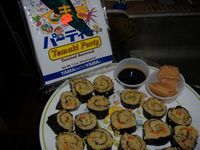 PREPARATION PREPARATIONI made my quinoa in the rice maker. It took 20 minutes using a 1 part grain 2 part water ratio and salt. I am SO very impressed. This is a non allergen for my son and high in protein and has so many other benefits I don't know why I haven't used this grain sooner. I really like this stuff and these ecclectic sushi rolls I made with it. Click on and wait about 20 minutes, use when freshly done (while the grains are still somewhat wet and clumpy a little, after a bit they will separate to be more like a pilaf grain). Oh, don't use a cheap (non high temp) "rubber" spatula to get the grains out of the rice maker pot. I'm not telling why or posting pictures. I was so happy to FINALLY pull out the bamboo mat that I got for Christmas last year (along with a book titled sushi for dummies). I scooped about 1/3 C quinoa grain onto my 1/2 sheet seaweed. Laid 2 thin sliced carrot, celery, and mushroom onto it and rolled. After making 4 rolls, slice into 1/4 - 1/2"pieces with a very sharp jagged knife. Here they are served with a side of my homemade pickled ginger (thanks for a food network pointer from amy's comfort kitchen) and Newman's Lite Sesame Ginger dressing. I really didn't think I liked this dressing until I dipped one of these into it and then decided to make a salad from the leftover quinoa. I added about 2 cups more chopped, shredded, or diced veggies to it and 1/4 cup of the newman's dressing. I will do this again. Good stuff, just don't expect to frig them and eat them later, they seem to dry out. HOMEMADE PICKLED GINGER-2 cups rice wine vinegar -1 tablespoon salt -1/2 cup sugar (or sub 1/2 tsp KAL brand stevia extract powder) -1 small red beet, peeled and halved -2 bay leaves -1/2 tablespoon white peppercorns -2 cups ginger slices, peeled (1/8-inch thick) PREPARATIONCombine everything but ginger in a saucepan and bring to a boil. Add ginger and turn heat down to a simmer for 1/2 an hour. Pull off heat and let stand until cool, about 1 hour. Place in jar and refrigerate overnight. Will keep for 1 month. Weird maybe, but I've been throwing some slices of this into my salad, topping with some lemon juice, sweetener, salt and pepper. I'm not raving about it, but it was pleasingly different. Maybe a little coconut will take this salad to the thai extreme.
Vegan Visuals
What does vegan means? This is what the word vegan represents in the image world (as browsed on google): pretty cool, uh? But again, you KNEW you are cool! Believe me, meat eaters do not do half as good... COMICS
 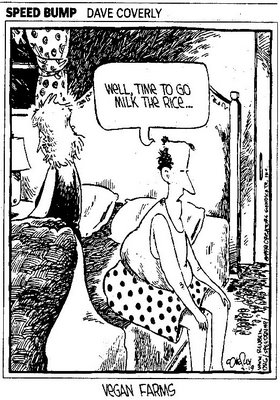 
PHOTOS 
  
GRAPHICS
    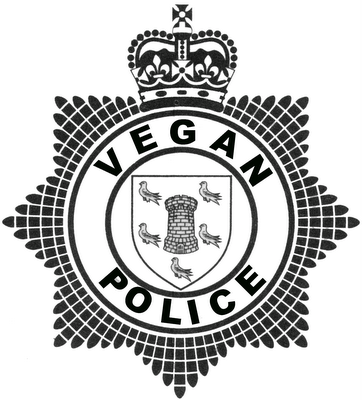 What's your favourite out of the above? We like a lot the SuperVeganMan! Got any more to share? What's your favourite out of the above? We like a lot the SuperVeganMan! Got any more to share?
-----------------------------------------------------------------------------
P.S.1 - One of our member, Allie of A Vegan Life, has started her own cooking contest about vegan desserts: she is going to try each recipe and submit it to her family for ratings. We think this is SUPER cool since Allie is our youngest member (I am sure she is not very happy to always hear comments about how young she is: sorry Allie!) and she is just 14 years old!
Have you got a recipe for her? Send her one by email, after having read the rules here.
P.S.2 - July seems to be the great celebrations month: Canada Day on July 1st, Independece Day on July 4th and the Pres De La Bastille on July 14th! Wherever you are, happy celebration! I just rencelty discovered it is a custom for Indepence Day to eat read, white and blue food: pretty challenging to get anything but blueberries to count for the blue! If you are considering food colouring for your dishes and have missed the great baseball lunch at Vegan Lunchbox, have a look at this product from Vegan Essentials: vegan, totally natural and safe for everybody!
Vegan information overload
You have probably know this for long. We reached this stage only now, after countless hours of browsing the net for vegan information. We discovered that there is too much to talk about: too much to choose from! We have run into stories of vegan vixens and vegan cartoonists, vegan country premiers and vegan company presidents, vegan weddings and vegan pastry shops. There is too much to talk about: vegan mints, vegan tanning lotions, vegan clothing lines, vegan conferences, vegan anything... all done by dedicated vegan people, like yourself. This is just too much to talk about! So where to start? Maybe with one of the most bizarre news on the vegan planet. The title of the article was definitely NOT promising: Vegetarian Artist to Eat a Whole Cow for Charity( here). It reminded me of a really nightmarous story many Canadians and Torontonians will remember (I am referring to the brutal cat skinning and beheading by the hands of the former vegetarian, self declared "artist" Matthew Kaczorowski) and I just was not impressed. but reading futher the story became a lot more interesting and filled with positive connotations: (as appearing on PRWeb)British artist Damian Hurst famously pickled whole animals. Now, a Portuguese vegan artist from Glasgow School of Fine Art has arranged an installation that will encourage members of the public to eat a whole cow. But is it art?
Glasgow, UK (PRWEB) June 18, 2006 -- 25 year old artist Zoe Birrell’s work is featured as part of Glasgow School of Arts’ Degree Show -- An annual exhibition of final year work from Fine Art, Architecture and Design.
The Times Newspaper and the Independent Newspaper have both chosen Glasgow School of Arts’ Degree show as the best Art show to visit in Scotland.
The Times said: "This is the best opportunity to discover artists before their reputations and prices soar; the Independent described the event as ‘one of the 'best degree shows' outside of London."
Vegetarian since the age of 14 and a Vegan for the last 5 years Zoe decided to explore the issues of intensively farmed animals related to her own femininity. The life of the modern dairy cow, kept perpetually pregnant and thus full of hormones whilst suffering the emotional stress of loss of her baby calf inspired Zoe to focus on these psychological and physiological issues and the ethical alternatives.
Zoe has cast her own body weight of delicious dairy free vegan chocolate,  donated by Plamil Foods, into a herd of 420 chocolate cows, 300 of which the public will be invited to purchase and eat. donated by Plamil Foods, into a herd of 420 chocolate cows, 300 of which the public will be invited to purchase and eat.
It’s hoped the money raised will go to a animal sanctuary such as Hillside where they can save the life of a dairy cow (who typically have a working life of only 2-5 years) or a male calf destined for the veal crates of Europe or catfood.
There will be a small booklet that accompanies the exhibition and discusses some of the wider issues relating to human health and nutrition and environmental concerns raised by treating animals the way we do.
The Exhibition at The Mackintosh building in Renfrew street is open to the public every day from 10 am to 9 pm until June 25th.
Glasgow School Of Art, Mackintosh Gallery, 167 Renfrew Street
Glasgow Lanarkshire G3 6RQ –
0141 353 4500 - http://www.gsa.ac.uk
From Jun 17, Mon-Fri 10am-5pm, Sat 10am-2pm, ends Jun 24 2006 Entrance - Free
Artist's Statement
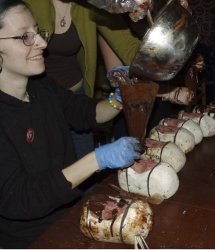 A model of a dairy herd made from organic vegan chocolate composes the main body of this work. Each cow is a solid cast made out of 87% cocoa chocolate produced by a vegan company (in which no animal ingredients are ever used). The cocoa's from a fairtrade scheme in the Dominican Republic that pays particular attention to women's rights. The number of cows in this herd is defined by my own body weight (53kg) as this is the amount of chocolate being used for the casts. This makes a total of roughly 480 cows. Some of these will be used in an installation but the majority of them have been packaged as consumer goods and will be sold individually. All these cows have been made in a food safe environment and are intended for consumption. The funds raised from selling these model cows will be divided into two part: the first will be used to rescue and re-home a calve (who would be considered surplus and put down) from the dairy industry and find it a suitable and safe home to live in, the second half will be used to fund similar projects in the future. All the packaging used is, as far as possible, eco friendly. The installation space used a series of alternative ways of refrigeration in order to create an adequate storage environment for the chocolate. A model of a dairy herd made from organic vegan chocolate composes the main body of this work. Each cow is a solid cast made out of 87% cocoa chocolate produced by a vegan company (in which no animal ingredients are ever used). The cocoa's from a fairtrade scheme in the Dominican Republic that pays particular attention to women's rights. The number of cows in this herd is defined by my own body weight (53kg) as this is the amount of chocolate being used for the casts. This makes a total of roughly 480 cows. Some of these will be used in an installation but the majority of them have been packaged as consumer goods and will be sold individually. All these cows have been made in a food safe environment and are intended for consumption. The funds raised from selling these model cows will be divided into two part: the first will be used to rescue and re-home a calve (who would be considered surplus and put down) from the dairy industry and find it a suitable and safe home to live in, the second half will be used to fund similar projects in the future. All the packaging used is, as far as possible, eco friendly. The installation space used a series of alternative ways of refrigeration in order to create an adequate storage environment for the chocolate.
At the core of this project there is a desire to look at the way we perceive and engage with ourselves, and other around us in the society we live in, be these human or non-human animals. I am also looking at how this affects the environment we live in. My role and place as an individual in this equation is manifest by my body weight defining the size of the herd. The fact that I am a woman and I am creating an entirely female herd is not a coincidence as this herd is the result of the exploitation of another animals’ sexuality. The use of fairtrade organic vegan chocolate is specific in that it highlights how our consumer habits affect the rest of the world. The use of ecological and sustainable alternative refrigeration systems is a reflection of the effects of cattle farming on the release of greenhouse gases into our atmosphere. This work came about as a culmination of the collision of my love for other animals and art. It is the fruit of research, practice and education in both these fields.
Artist who interest me and have in some way influenced this work are people like Sue Coe, Janine Antoni, and Jethro Brice. Sue Coe’s prints intrigue me in that she is one of the few artists who used nonhuman animals in her work in a direct reference to themselves and welfare concerns surrounding them. In all my studies I have found that there are a lot of nonhuman animals in art but a very limited amount of art about nonhumans. Janine Antoni interests me in her use of consumables such as chocolate and lard to relate to herself. Jethro Brice’s work interests me in his engagement in the environment that surrounds us and almost his obsessive concern in making work from sustainable materials that have been recycled from the world around him.
Wow, I am glad and impressed! As bizarre this may sound (some website reporting the news thought it was pretty funny), the initiative seems sound to me: I have visited GSA (Glasgow School of Arts) a few years back and it is definitely on of the top 3 art schools in the UK if not the entire Europe. It is great to see such an awareness campaign to start from there! Go Zoe! Plus, I confess I would gladly buy one of those small cows, even if slightly pricey for my pockets (5 pounds each for about 100 grams of chocolate)... and I would definitely be unable to hold myself from eating it!
Recipe: Delightful Millet
Mind you, I wanted to title the post "Millet, the Friendly Stranger", since it rarely enters in my grocery list (I use it only in one recipe for soup, of all things) and despite loving it, as most dry foods, I tend to forget it in the pantry. So for me it is some sort of friendly stranger. But wait: that is also the name of a well known.... ermh.... herb shop. Not 'herbal': that place sells weed. Legally or illegally, I don't know. And since this wants to be a kid-save zone, that title started to sound wrong in my head: I do not want to promote any sort of smoking activity in here!
Anyhow, I will hand out the post to Danielle from Supper And The Single Girl now, who was so kind to donate to the club a fantastic millet recipe (very worth trying, especially if you like those half salty/half sweet dishes. I have also tried it with quinoa and dried prunes and raisins and it was delish!), which you can see pictured below.
 DELIGHTFUL MILLET DELIGHTFUL MILLET INGREDIENTS
1/2 cup pine nuts
1 cup millet
2 cups water
1/4 cup dried cherries
1/4 cup chopped dried apricots
1 tsp coriander
1 tbsp nutritional yeast
PREPARATION
Rinse millet in a strainer and set aside. Toast pine nuts until they brown a bit. Add millet and stir for about a minute. Add water, dried fruit, and seasonings and stir until water comes to boil. Lower heat and simmer for 15 minutes or until water is absorbed. Serve. I have to confess I keep playing with the coriander and nutritional yeast amounts. I'm also playing with the instructions a bit. Enjoy!
"Cooking with Quinoa Contest"
 Ladies and Gents, come and see the quinoa fair! Our first contest has started! We asked you to come up with quinoa recipes and these are the wonderful recipes you invented! Compliments to everyone: your creativity seems without borders! From breakfast creation to desserts, quinoa has stretched over any meal! Thanks a million to everyone for joining in! This is the list of wonderful dishes you have invented, published in the order I recieved them.  1- Dori at The Bakehouse - California Quinoa Sushi rolls 1- Dori at The Bakehouse - California Quinoa Sushi rolls
*
*
*
*
*
*
*
 2- Dori generously entered also this recipe - Quinoa Burgers 2- Dori generously entered also this recipe - Quinoa Burgers
*
*
*
*
*
*
*
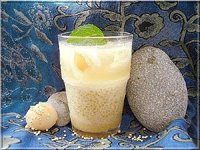 3- Bea at Vegan Fields - Quinoa "blanc-manger" with lytchees & rose jelly (here in English) 3- Bea at Vegan Fields - Quinoa "blanc-manger" with lytchees & rose jelly (here in English)
*
*
*
*
*
*
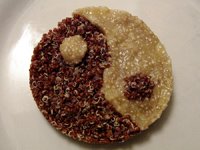 4- Erin at Zenpawn - Qalming Quinoa 4- Erin at Zenpawn - Qalming Quinoa
*
*
*
*
*
*
*
 5- Melody at Melo Meals - Quinoa Sushi Salad 5- Melody at Melo Meals - Quinoa Sushi Salad
*
*
*
*
*
*
*
 6- Primary Consumer at A Day In The Life of a Vegan- Creamed Mushroom and Spinach with Quinoa 6- Primary Consumer at A Day In The Life of a Vegan- Creamed Mushroom and Spinach with Quinoa
*
*
*
*
*
*
 7- Virginie at Absolute Green - Clafouti au Quinoa (here the recipe and here the post in English) 7- Virginie at Absolute Green - Clafouti au Quinoa (here the recipe and here the post in English)
*
*
*
*
*
*
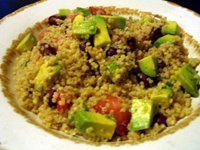 8-Teddy at Fun With Your Food - Extra Simple Quinoa Recipe 8-Teddy at Fun With Your Food - Extra Simple Quinoa Recipe
*
*
*
*
*
*
*
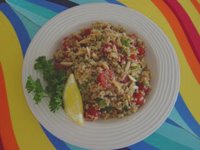 9- Vicki at Vegetarian Family -Toasted Quinoa Salad 9- Vicki at Vegetarian Family -Toasted Quinoa Salad
*
*
*
*
*
*
*
Please cast a vote! We want to know what recipe you think is the best! Votes will be open for one week(closing date: June 30th night): to cast a vote, leave a comment mentioning either the recipe name or the entry number. You can also tell us what you liked the msot out of this recipe! The meter of judgement is up to you: criteria may vary! We just want to know what you think is the best! You do not need to be a regular here to express your preference!
Super Three Layers Chocolate Cake
Today we had a (vegan) birthday in the "Club family". Hence, we though of a super cake to celebrate: by far our most daring cake project so far! 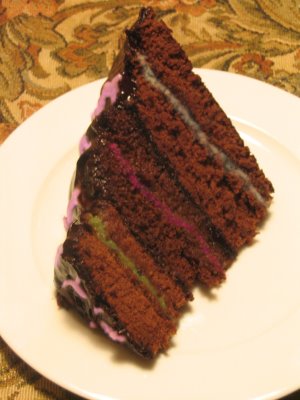 We truly liked the idea of a three layers chocolate cake with different fillings and so we decided to go that way. Using online resources and a variety of cookbooks, we finally came to this recipe (a bit improvised to be honest!): it seems VERY elaborated but it is not really. We managed to clean after ourselves and the final result was pretty worth the effort! SUPER THREE LAYERS CHOCOLATE CAKEINGREDIENTSFor the chocolate sponge layers: (adapted from this recipe from Fat Free Vegan to be cooked in a microwave)Biggest sponge:-1 cup flour -3/4 cup water -one dash of salt -2/3 cup sugar -1 teaspoon natural vanilla extract -2 tablespoons cocoa -2 teaspoons baking powder Medium Sponge:-1/2 cup flour -3/8 cup water -one dash of salt -half a teaspoon natural vanilla extract -1 tablespoon cocoa -1 teaspoon baking powder Smallest Sponge:-1/4 cup flour -1/4 cup water -one dash of salt -1/4 teaspoon natural vanilla extract -1/2 tablespoon cocoa -1/2 teaspoon baking powder For the fruit fillings:-one banana -200 grams of cherries -one and a half kiwis -half a cup of soy milk -150 grams of sugar -agar agar flakes For the chocolate filling and frosting:-200 grams dark chocolate -200 grams sugar -half a cup of soy milk For the pink icing:-half a cup of icing sugar -5 red cherries Plus you will need three pyrex microwaveble deep dishes to cook the sponge cakes in. PREPARATIONStart making the three spongy layers. Start with the biggest one. Mix all ingredients and put in the largest pyrex deep dish, previously well oiled on the bottom and sides and generously dusted with cocoa powder (use a fine colinder for this operation, needed to take out the cake easily from the baking dish). Cook at 750 W for about 7 minutes, until a toothpick comes out clean. After the cake has rised and cooked, take it out of the pyrex using a lid or a plate (for us was enough to turn the cake upside down to make it come out easily). Put on a cooling rack and when the cake is at room temperature, slice it in two disks. Do the same for the other two layers. The medium one should cook about 5.5 minutes, while the smallest one should cook for about 4 minutes. While the layers cool, start preparing the fruit fillings, one for each sponge you made. Start with the banana, which in our case went at the bottom. Put the banana in a blender and blend until it is a smooth cream. Add 75 grams of sugar, about 1 teaspoon of agar agar flakes and some soy milk to get a smooth, liquid cream. Put in a small pot and bring to boil. Boil until the cream starts to thicken. Spread on the bottom layer of the largest sponge cake. Cover with the other half. Take the kernel out of the cherries and blend with 50 grams of sugar and 3/4 teaspoons of agar agar. Add soy milk as needed to get the same consistency of the banana cream. Put on the stove and boil until it thickens. Spread in between the two middle disks. Do the same with the kiwi, adding the remaining sugar and just half a teaspoon of agar agar and place in between the two smallest disks. Now, to 'glue' the three layers together, prepare a creamy and soft chocolate frosting. Melt the dark chocolate with the sugar and the soy milk. Make sure all the sugar has dissolved. Spread a generious layer of cream on the top of the largest sponge and put the medium on it. Then coat the top of the medium layer with the same cream and put the smallest sponge in place. Don't give up now! You are almost done! Carefully fill all the holes with the chocolate cream and then proceed to cover with it the entire cake, proceeding from top to bottom. Make sure to put an even layer on the cake and to cover well all areas! Try to even the surface as much as you can. Let the chocolate frosting set for at least one hours before doing anything else. At this point squeeze in your hand the cherries (with a knife make some cuts on the cherry skin before, so to get out as much juice as you can), collecting the red juice in a small cup. Add in the icing sugar (enough to get a pretty solid consistency). This extremely simple procedure gave us a fantastically pink icing sugar (our celebrated one was a girlie!), just that shade of pink that screams 'artificial colourings!' Yet, it is totally natural! We were super happy of the result. Put the icing sugar in a decorating pen (or a clean plastic glove with a small hole in one of the fingers) and decorate the three layers with the best design you can think of and let it set. Wait for the candles to blow and slice your deliciously sinful three layers cake! Enjoy!---------------------------------------------------------------------------------- We believe we got all the entries for the "Cooking with Quinoa contest" and we plan on opening the votes tomorrow. Any late comer?
People Watching: ENGINE 2
Think well: what is the most unlikely environment to see people consuming vegan meals? A gym? Ok, the guys on steroids are not very likely to gorge on tofu, but gyms are full of healthy conscious individuals, no? And within those, there must be vegans... Plus, we have proofs of the exhistance of vegan body builders if you thought making it a body builders gym would have done the trick. No, a gym does not sound like a good bet at all. A poultry farm? I am pretty damn sure there are vegans in there! With what people must see everyday, who would not become one? Plus, there always is that occasional undercover animal right activist (who receives all our love), on sight to tape a shocking documentary. A police station? Uhm... this seems a tough one. But we have faith there are some vegan policemen since at least one made it to on-silver-screen glory ( Christopher Walken in the 2001 movie titled Scotland, Pa., in which he acts in fact as a vegan policeman). A firefighter station? This must be it: one of the most unlikely environment on the planet to see people eating vegan. Firefighters, a bit like policemen, are those donut eating people with sky high cholesterol level and a friendly smile, no? No doubt they are heroes, but they are definitely not known to be the kind-on-the-animals type. Yet, we are so glad to discover we were totally wrong! Thanks to a link from What Do Vegans Eat, we landed on the super nice Engine 2 website, collecting the bios, press articles, recipes of... 4 vegan firefighters located in Austin, Texas! Almost unbelievable, right??? Yet, Lieutenant Scott Walters, Specialist James Rae, Firefighter Matt Moore, Firefighter Derick Zwerneman and Firefighter Rip Esselstyn are the living proof that stereotypes are false and that vegans are already to be found in every working environment and are soon to conquer to world! These initially four, now five firefighters two years ago started an adventure that finished in press glory: motivated to cook for each other by their schedule, which sees them working a 24 hours shift every three days and pushed by alarming facts about cholesterole related health problems running in their own families (James Rae's cholesterol level was then sitting at an allarming 344 and he was coming with a family with a long history in heart diseases), they started a plant-based, whole grain diet. Originally our heroes' wagons (this is the word used for meals in a fire station) were flexitarians, with the occasional chicken and fish, but in a year time they had turned to a strict vegetarian diet, based on the 4 foud groups, in their own words, " the fantastic four"(which is also a nice alter ego name for our firefighters heroes!): fruits, veggies, whole-grains and legumes. Now, in the name of their quest for health, they avoid all animal products! The perfect way to become heart attack proof, as it was in their intent! 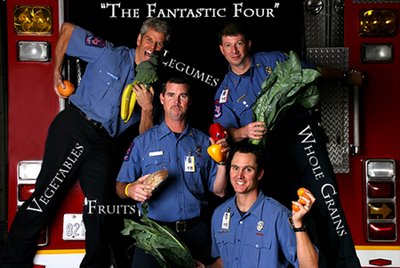
Their adveture, which has turned Engine 2 into The House of Health (as you can see in the picture here), paved the way for many welcomed recognitions: not only the New York Times and National Public Radio wrote and talked about them, but they started reciving free meals from vegetarian restaurants, not to mention the great deal of interest they caused in the female population... Their collegues are stopped by attractive women asking if they are the 'vegetarian firefighters' and with requests for a calendar and their recipes!
(apparently the most popular one is Paul McCartney Enchilladas! Engine 2 has been so nice to publish recipes on their website)
Despite all this fame, Engine 2 cannot afford to forget about their duties: on the contrary, to promote their quest for health, they have developed the Engine 2 High 5 Challenge, to inspire all of us to follow a healthier life avoiding useless risks (in the end it is often up to them to come and rescue us from troubles we caused ourselves!): EAT:
5 pieces of fruit each day
5 different colored vegetables a day
5 helpings of brown rice, whole grain breads, or whole wheat pastas a day
DRINK:
5 glasses of water each day RECRUIT:
5 people to join you
WALK:
1 mile per day, 5 days a week
CHECK:
the batteries in your smoke detector the 5th of each month 
As they say:
FIGHT FIRE - FIGHT CHOLESTEROLE - FIGHT FAT and if we can add: GO VEGAN!
Friendly Publication: The Vegan Passport
The summer is here. And we all want/dream to travel: exotic destinatins, the white, soft sand, the hammock between the palm trees, the crystal clear water... Well, this sounds too much like a commercial for animal tested tanning lotion, does it not? So let's leave it at that: imagine what you want of your dream vacation! It does not matter what the setting is like: the important thing is that you manage to enjoy your vacation, including the food! Because food can definitely be one of the biggest problems of travelling on a vegan diet... You know how it is: if you have the luck to have a semi-kitchen when on vacation (often just a burner and a pot), you end up having pasta for days on end. If not, it is a hit-or-miss kind of deal: supermarket, bakeries, street joints... And often you are not able to find much at all. Everything looks tempting and at the same time not vegan, the ingredients lists on supermarket products are written in.. oh! Czech! Swahili! Korean! Damn it! There must be a way to find vegan food without wasting hours otherwise devoted to sightseeing on this nerve wracking hunt! 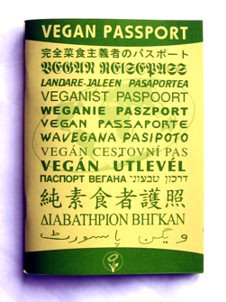 Well, rejoice! Apparently there is a way! Some fellow vegan has investigated the problem and has come up with a brillian solution. The Vegan Passport was born! The Vegan passport is a great little book first published in 1996 and written by George Rodger, chair of The Vegan Society, and just recently (not even a year ago: July 2005) re-edited. What's in it? Basically it is a way for vegans to communitcate our needs with restaurant/supermarket/street seller staff in order to grant ourself a vegan meal while travelling the world!But there is more! Read on to find out! " The essential passport sized travelling companion for vegans has now increased from 38 to 56 languages, covering 93% of the world's population, with a page saying what vegans do and don't eat in great detail. Let the waiter show it to the cook and you'll be sure of a totally vegan, animal free feast in restaurants anywhere even if no one speaks a word of your language. Includes:English, Afrikaans, Albanian / Shqip, Arabic, Basque / Euskera, Bengali, Bulgarian, Catalan, Chinese, Croatian / Hrvatski, Czech, Danish, Dutch / Nederlands, Finnish / Suomi, French, German / Deutsch, Goan / Konkanim, Greek, Gujurati, Hebrew, Hindi, Hungarian / Magyar, Indonesian, Italian, Japanese, Kannada, Korean, Malagasay / Malagache, Malay, Maltese / Malti, Marathi, Mongolian, Nepali, Norwegian / Norsk, Persian / Farsi, Polish, Portuguese, Romanian, Russian, Serbian / Srpski, Shona, Sinhalese, Slovak / Slovensky, Somali, Spanish, Swahili, Swedish / Svenska, Tagalog / Filipino / Pilipino, Tamil, Thai, Turkish, Ukrainian, Urdu, Vietnamese, Yoruba, Esperanto." (source: Vegetarian Guides- mapping the world for vegetarians and vegans) Now. We think this is definitely a comprehensive list! Unless you are going to... uhm... the north pole? Anyhow, consireding the passport is not very expensive (about 7 US $ and it pretty easy to carry!), it is a excellent thing to keep handy when abroad! We suggest you to make sure to buy the updated, most recent edition, thing you cand do from the following websites (buying from these directly means helping these companies instead than giant online sellers like Amazon, which has anyway run out): - The Vegan Society Online Shop- Vegetarian Guides (shipping worldwide) - Food FightNot going all the way to the Philippines but still worried about finding vegan food? There are other guides which may just be for you. We particularly like: - Vegetarian Europe: "Edited by Alex Bourke & 29 bilingual Veggie Guides authors. Detailed descriptions include animal, dairy and egg free dishes and desserts, plus prices and opening hours, for a wonderful holiday in 23 countries from Scotland to Greece, Portugal to Russia. Plus veggie vocabulary, maps and addresses of local groups for long stayers" ( here you can read a sample about Paris and here about Prague). - Vegetarian France: "By Alex Bourke & Alan Todd. Researched by France's leading vegetarian publishers Editions La Plage, translated and adapted by Veggie Guides founder Alex Bourke, who lived in France for two years". - The New Spain - Vegan & Vegetarian Restaurants: "By vegan chef and restaurateur Jean-Claude Juston. Over 100 vegetarian and vegan restaurants throughout Spain, Mallorca and the Canary islands. Also things to do in each area, places to see and shop, bookshops, cinemas, tourist offices, vegetarian magazines and websites and associations in Spain, and even some Spanish vegan recipes, for when you get home". - Vegetarian Israel: "By Mark Weintraub. More than just falafels, Israel is a vegetarian and vegan paradise. Includes restaurants in Jerusalem, Tel Aviv, Jaffa, Haifa, Tiberias, Galilee resorts, Moshav Amirim, and top winter destination Eilat on the Red Sea. Also health food stores in Jerusalem, Tel Aviv and Haifa". - Vegan Guide to New York City: "By Rynn Berry & Chris Abreu-Suzuki with Barry Litsky. From Harlem to Wall Street, Manhattan is vegan and veggie nirvana. Over 100 restaurants plus health food stores, ethnic cuisine, famer's markets, raw food places, top 10 juice bars, bookstores, even where to buy vegan shoes". - Vegetarian Britain 2006: "Edited by Alex Bourke. This new edition has over 25% more entries, more maps and indexes. 170 vegetarian, vegan and veg-friendly hotels and guest houses. 600 cafes and restaurants. 500 city center wholefood and health food stores" (you can read a sample here and see some of the pages here). - The Vegetarian Traveler : Where to Stay if you are vegetarian, vegan, environmetally sensitive: "By Susan Civic. The Civics are the owners of Environmental Travel, an agency that caters specifically to the vegetarian community. Here they offer a travel guide of accommodations for vegetarians, vegans, and the environmentally sensitive, listing bed-and-breakfasts, spas, and hotels worldwide". - Veg Out Vegetarian Guide to San Francisco Bay Area: "By Michele anna Jordan. Gibbs Smith, Publisher, offers two new installments in our groundbreaking new series of restaurant guidebooks for vegetarian and vegan diners. VegOutTM vegetarian guide books virtually eliminate the difficulty of finding vegetarian and vegan offerings in a world of shish-kabob street vendors and hot dog hawkers". Any other book you have sampled? Share your knowledge with us! And see you at that tiny vegan joint in Malaysia! P.S. Not even 5 years ago, a book shortly appeared on the shelves of Chapters. We cannot remember the title but was a 200 about pages paperback book working on the same concept of the vegan passport: many languages featured and a lot of sentences to ask for vegetarian/dairy free/vegan meals in the most unlikely languages spoken on the globe. We bought one as a present and did not pick up our own copy. Anybody has it or know the title? It seemed an excellent vegan travelling reference book, we would love to be able to find somewhere!------------------------------------------------------------------------------------ Still about the topic of vegan travelling, have a look at one of our newest member page: What Do Vegans Eat. The interesting thing of this page is that anybody can log in and publish pictures and reviews of vegan food you find on your way to work/at the local market. We think it is a great idea to provide locals as well as passerbys directions to vegan food in your own area. So if you have pictures and directions to spare, take a moment to log in your entry, wherever you are on the planet! Your imput may be useful to other vegans : )
Spotlight on a Website: DA VEGAN CODE
 Shhhh... Don't tell anyone! Did you know of the exhistance of a secret society, named Da Illuminati di Veganique Ancienti, holder of the ancients, hidden secrets of Da Vegan Code? As much as you may think I made it up, I claim not to know anything about it: KleoPatra, over at Pisces Place, a few posts back linked to this page (is she a member maybe?), and, since it is our desire to present you with the best of the vegan world, I had to dutyful investigate the matter. For centuries Da Illuminati di Veganique Ancienti have preserved the code and kept it secret, bearing struggles and fighting battles: many men and women have died, others have survived, passing on their (vegan) children the bearing marks of Da Illuminati di Veganique Ancienti secret society, which is still thriving today. Not much is known about them and their secrets are still hidden in the deepest mystery, but recently the society has revealed through Da Vegan Code website some of their beliefs, 'revealing that the code of ethics began long before carpenter Donald Watson first coined the word vegan and founded The Vegan Society in 1944. The Vegan diet and Vegan code of ethics that Da Vinci advocated 400 years previously shows clearly that vegan values are truly ancient and far from being a modern phenomenon. Da Vegan Code has origins reaching back to the dawn of mankind'. But that is not all: a mysterious decalogue of rules (possible meant to initiate novices into the secret society) also appeared. 1) ABSTAIN from the Eating and Wearing of beasts
2) AVOID the Exploitation of all living creatures
3) Tread lightly upon the Earth for the benefit of People , Environment and Animals
4) Seek out Health and Happiness
5) With Knowledge comes Responsibility disperse it wisely
6) Vegducation is salvation - spare no one
7) Seek out the truth - The Sharpest Sword
8 ) Spread Chocolate generously - especially on Loved ones
9) See, Hear , Listen, Smell, Touch, Think - Taste Nature's Force
10) Shine brightly and Illuminate the World - Pity those swimming the Wrong Way for they may drown.
Pretty mysterious, uh? It's a secret society in the end (by the way, I especially like number 8!). It is all too intriguing not to investigate further, so I decided to test it all out on myself and undergo the procedure needed to become a novice of the secret society: if I survive, I will present you an accurate report about the hidden secrets of veganism. If I do not, I guess I should inform you now that Da Vegan Code, as it is, rocks! Their website is the funniest spin-off the much more boring Da Vinci Code I have seen so far and an excellent counterculture idea! Way to go for using mainstream mass products like this book/movie to promote veganism! Also, if you click on the 'Shop' button, you are presented with a super exclusive selection of uber trendy t-shirts, aprons (one of my favourites: who would not want a kitchen apron saying "Secret Society Of Vegans"?)), buttons and what not, all shipping worldwide! So if you need an extra t-shirt, you want to check out their selection. My dear fellow vegans, I bid you farewell: we may never see each other again if I die in the process, but may the though of your make me stronger in the hard journey I have in front of me: Da Vegan Code, here I come! The mystery just get thicker and deeper.... an anonymous (they are a secret society in the end no? there are sooo mysterious) claimed that Da Vegan Code and The Secret Society Of Vegans are unrelated: well, nothing too strange here, this is obviously a move to make things as unclear as possible. I am telling you, we are already uncovering some of their secrets! Anyhow, if you want to investigate the matter further, the SSOV ( Secret (keep this word well in mind!) Society of Vegans) has indeed a separate website you can view here (keeping in mind there are two links to this page from the Da Vegan Code homepage: things are getting confused... time to get out my Sherlock hat!). ------------------------------------------------------------------------------- You are all still in time to drop by here and leave a quinoa recipe! Just a reminder!
S.P.Q.R.
You will excuse me for writing something so far fetched. But outside of our friendly and welcoming vegan circles, being vegan in today's society is far fetched. Hence, I though that moving at the fringes of the culinary discussion may be interesting. What did i do? I went looking for old recipe books, to find proof of vegan dishes dating back in the centuries. But unhappy of that (we all know how our ancestors were unable to put meats on their plates most of the days, therefore, unsurprisingly, vegan recipes abunds in old cooking text), I went as far as I could strech it in history: the first cookbook recorded in the Western World that has survived to us, De Re Coquinaria, written by Apicius, in the last decades of the 1 st centuryA.D. Ladies and gentleman, welcome to the ancient Rome! First a few words about the author and the time this recipe book was written. Marcus Gavius Apicius (you can find some information about him on ViciPeadia, that's right folks, WikiPedia in LATIN! Alternatively, here in English) was one of the greatest gourmet of his times: he was so in love with food that the legend states he suicided because scared of dieing of starvation, unable to afford the sumptous banquets he got famous for, when he ran out of money at the end of his life: fear of death by starvation caused him to take his own life! He wrote in the 1st century A.D., in the high time of the emperial era of the Roman Empire, closed the Republican time with the deth of Ceasar in 44 B.C. While the Republican time was a period when morigeration was considered a sign of virtue and was applied to as many public and private occasions as possible, with an emperor sitting on a throne things changed dramatically. The presence of one family dominating clearly above all the others meant that everybody tried to show off their money in every way possible: morigeration was thrown to the wind, and display of luxury became the rule. In fact Apicius wrote the De Re Coquinaria as a guide for the lucullian banquets of his time: and indeed he was a contemporary of Lucullus himself, even if likely the two weren't friends since Apicius never make any reference of him in his book. Was I going to find vegan recipe in this book, almost 2000 years old, together with recipes to cook cranes??? Well, keep on reading to discover! I have been having this short book for years, but put off from the introductory chapter on minced meats, I never gave it too much thought. Until curiosity clicked in. And I became able to skip chapter I and II to land pretty safely on chapter III: Cepuros - The Vegetables. Do not think this is a classic recipe book: there is no ingredient list nor exact quantities. Everything is pretty approximated, since anyway a scale was not a kitchen tool at the time! Each recipe is just given a title and the preparation instruction, giving the chef an idea of the ingredients to be used. Nevertheless, each recipe is pretty clear and not hard to follow. Also, remember that Romans cooked without potatoes, tomatoes, bananas, chocolate and lots of other ingredients that are staples of our diet nowadays. Cherries had just ben introduced, honey was the only sweetener known, desserts were pretty rare and seldom prepared. Yet, the recipes are interesting and they seem pretty tasty! In my browsing throught the chapters, especially the III and even more so the V, titled Ospreon - The Legumes, I found a number of recipes based on vegatables, legumes and fruit. And, hidden in the lines, even a hiddedn gem: the reference of an ente-litteram vegan!!!This little discovery made my day! The first recipe for moist bread is named after Didus Julianus, Roman emperor who was said to eat vegetables only! Now, this emperor was not particularly famous or deserving praise (as a matter of fact he does not seem to be a ruler gifted with a strong sense of morals, since he got his title basically with bribe): nevertheless, I am willing to break a lance in his favour, since he was a vegan in those ancient times (think! No carob chocolate, not vegan ice cream, no vegan chips available. No wait: none of this exhisted in the non vegan variety anyway!). And flipping the page over, voila'! I found my vegan recipe: "Fave beans cooked at the manner of Vitellium". It has been a pretty hard task and for a pretty silly reason: while vegatbles based recipes not calling for meat, fish or dairy abunds, I had not kept into account the fact that salt in the Roman times was a luxury good and not very widespread. For this reason, to flavour food, most recipes calls for (a pretty nasty) fish sauce. But swapping it with salt, many recipes are easily veganized. This one does not even need that extra step. So I cooked and taste and approved the flavour! The onyl thing you are left to do is to treat yourself to a 2000 years old recipe! Snow Peas or Fava Beans at the manner of Vitellium
Pisam sive fabam vitellianam:Pisam sive fabam coques. Cum despumaverit, mittis porrum, coriandrum et flores malvaru. Dum coquitur, teres piper, ligusticum, origanum, feniculi semen, suffundis salem et vinum, mittis in caccabum, adiecies oleum, cum ferbuerit, agitas. Oleum viride insuper mittis et inferes.And now in English, shall we? Keep in mind I improvised quantities, so feel free to change amounts as it feels good. INGREDIENTS  -240 grams cooked or almost cooked fava beans (can be substituted with snow peas)-half a leek-coriander-some malva flowers (it is a medial plant I was so luck to discover in my garden: looking at the picture should give you and idea of how they look like, but if you do not find any, no worries. In my opinion their presence did not change the taste that much!)-one stem of wild (or regular) celery-some fennel seeds-oregan-about a third of a cup of wine (I used white cooking wine)-olive oil-pepper-saltPREPARATION -240 grams cooked or almost cooked fava beans (can be substituted with snow peas)-half a leek-coriander-some malva flowers (it is a medial plant I was so luck to discover in my garden: looking at the picture should give you and idea of how they look like, but if you do not find any, no worries. In my opinion their presence did not change the taste that much!)-one stem of wild (or regular) celery-some fennel seeds-oregan-about a third of a cup of wine (I used white cooking wine)-olive oil-pepper-saltPREPARATION  Cook the beans or peas. When they will have produced the typical foam, remove it and add the sliced leek, the coriander and the malva flowers. While the beans are cooking, grind some pepper together with the fennel seeds, the oregan and the celery. Add the mixture to the beans and add the wine, salt and a tablespoon of olive oil. Stir when boiling and when ready, serve with a teaspoon of olive oil on top. Cook the beans or peas. When they will have produced the typical foam, remove it and add the sliced leek, the coriander and the malva flowers. While the beans are cooking, grind some pepper together with the fennel seeds, the oregan and the celery. Add the mixture to the beans and add the wine, salt and a tablespoon of olive oil. Stir when boiling and when ready, serve with a teaspoon of olive oil on top. The oregan, coriander, fennel and celery add quite a bit of flavour to this dish: dose to fit your taste. I served the fava beans just like that, but I guess they would go well on a typical cereal of the time: bulgour (cracked wheat). Otherwise, if you are ok loosing the historical fidelity of the recipe, they could taste even better on steamed rice. Enjoy! By S.P.Q.R. ( Senatus PopolusQue Romanorum = the Senat and of the People of Rome, to whom this recipe belong and who have gifted us with it today)! P.S. Given the fact that Apicius has been dead for over 1900 years, we could not get permission from him to repost this recipe. Nevertheless, we are pretty sure he would be pretty happy to see his recipes prepared in today's kitchens, after so long since they were popular!------------------------------------------------------------------------- Once again, we would like to compliment Virginie of Absolute Green: not only she managed, at her total surprise, to be featured in the super prestigious Elle Magazine (French edition) as one of the favourite food blogs of the editors, but she was also mentioned in the newspaper Ouest-France, as one of the most interesting blogger of the city of Nantes! Once again, deserved congratulations!
The “forgotten” fifth flavour: Umami
By Bryanna Clark GroganEver wondered how to make your cooking something special? I am always in pursuit of flavor, partly because I love full-bodied, savory dishes, and partly because I want to show vegans how you can make wonderfully tasty plant-based cuisine. It was no secret in Japan or China, but only recently has the West heard about “the fifth flavor”: umami in Japanese, or xian in Chinese. (The first four accepted flavors were sweet, salty, sour and bitter.) Our tongues (through special receptors in our taste buds) can detect these five basic tastes. The other flavors we know are combinations of those basic tastes and are recognizable with the help of our sense of smell. (We have more than 300 receptor genes that, between them, account for every possible flavor known to man.) The term umami was first popularized by the scientist Kikunae Ikeda of the Tokyo Imperial University in 1908, but xian goes back to 3000 year-old Chinese book called the “Yellow Emperor’s Book of Internal Medicine” (thus it is sometimes also called the “forgotten flavor”). Although physiologists have long known the chemical compounds that provide its taste, only recently (in this decade) have they discovered the human tongue's receptors for umami. Particular amino acids and nucleotides, produced in foods when enzymes break down their proteins (through cooking or fermentation), stimulate these receptors, which then message our brain to register the deliciously savory taste of umami. Heston Blumenthal wrote in The Guardian: “In the west, for years we've used fat to add richness and fullness to the food we cook. In the Far East, however - and in Japan in particular - that added richness has long been provided by foods with a high umami content, most notably kelp and konbu, the dried seaweed that is used to make that versatile and essential Japanese broth, dashi. This broth really does lend a full-ness of flavor and a meaty tone - and with none of the fattiness that comes from using butter or cream, either.
Ikeda looked at the constituents of konbu, and found that the umami character was created by the presence of glutamates. It has since been found that other substances also carry these properties, notably inosinate and nucleotides. When foods containing these were combined in the right proportions, it was found that the umami character was magnified quite substantially.”
Actually, there are studies showing that umami-tasting compounds have magnifying effects on one another— combining two umami compounds produces 8 times more flavor than you would get from a single umami compound alone! A flavor explosion! Although difficult to put into words, umami has variously been described as “savoriness”, “deliciousness”, “meatiness”, “tastiness”, “mouth satisfaction”, “the good taste of food”, or “brothlike”. I particularly like the definition “ essence of deliciousness”. “ Umami can be described as intensity, what helps us determine whether we like something or not, and carries a whole constellation of physical reactions,” says Doug Frost, Master Sommelier and Master of Wine. As Seattle Post-Intelligencer food writer Hsiao-Ching Chou wrote: “Explaining umami can get a bit convoluted. But, your taste buds understand, and that's what matters.” What plant-based foods contain umami compounds? Fermented foods such as soy sauce, miso, balsamic vinegar, and wine (which also has its own special flavor-enhancing qualities—but that’s another column!); dried shiitake or matsutake mushrooms; sea vegetables; green tea; vegetarian bouillon; tomato juice and other tomato products. Browning foods by sautéing, grilling, and caramelizing also produces umami compounds. Umami is a powerhouse in meatless dishes, where it supplies the robust element that usually comes from meat or poultry. Try it yourself, by using deeply browned, or caramelized, onions in a vegetarian soup or stew, for instance, or in the following easy recipe, which employs Chinese ingredients containing umami compounds to produce a richly satisfying dish from what many consider to be a bland food-- tofu. The mushrooms are utterly delicious when cooked this way. An explosion of umami! BRYANNA’S BRAISED TOFU WITH CHINESE BLACK MUSHROOMSServes 4 From my book, Authentic Chinese Cuisine for the Contemporary Kitchen. 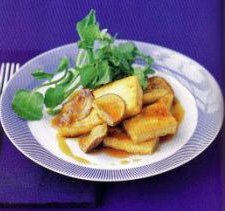 - 12-14 oz. Oven-Fried Tofu (see below) - 10 dried Chinese black mushrooms, soaked, stemmed, then cut in half (save soaking water) - 2 green onions cut into 1" lengths - 1/2 T. oil Braising Liquid:- 1 c. vegetarian broth - 1/4 c. of the saved mushroom soaking water - 1 and 1/2 T. soy sauce - 1 tsp. vegetarian stir-fry sauce (vegetarian "oyster" sauce—Lee Kum Kee brand) - 1/2 T. dry sherry - 1/2 tsp. sugar Finishing:- 1/2 tsp. cornstarch dissolved in 1/2 T. cold water - 1 tsp. Asian roasted sesame oil Heat a large wok or heavy skillet over high heat. When hot, add the oil. When the oil is hot, add the green onions and soaked mushrooms and stir-fry for 30 seconds. Add the braising liquid ingredients and bring to a boil. Add the Oven-fried Tofu and let the mixture boil until it reduces by half, which takes 5-10 minutes. Add the dissolved cornstarch and stir until it thickens, then stir in the sesame oil. OVEN-FRIED TOFUUse firm tofu. Pat dry. For triangles, cut the block in half crosswise if the block is rectangular rather than square, then each half in half horizontally. Then cut each of the four resulting pieces into four triangles. For cubes, cut into 1/2-1" cubes, depending on your needs. Place the tofu on dark oiled cookie sheets (dark sheets brown foods better) and oil the tops lightly, using an oil-spray mister or a brush). Bake at 500 degrees F, 5-7 minutes per side, or until golden and puffy. These may be frozen for future use. _______________________________________________Article, photo and recipe reposted with author's permission.Thanks a lot Bryanna for one of your always fantastic gourmet recipes and for the really interesting article! Bryanna is currently working on her next eBook, which will be about Seitan and that we cannot wait to read. Currently, she has also opened a contest to decide on the book title: the winner will recive a free copy and that is the best incentive for all of us to come up with an interesting title and drop our suggestion on her page!
Spaghetti squash with basil, sweet tomatoes, shallots and olive oil
After titillating our taste buds with the pictures of this dish from her site, Teddy is now kindly sharing with us the details of this great recipe! It looks so yummy I am calling all the supermarket of the area to find out who is now selling a Spaghetti squash (unfortunately, I am not having much luck...)
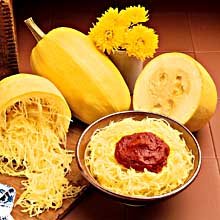 First a few nutrional facts: First a few nutrional facts:
Spaghetti squash originated in Mexico/Central America. There are different varieties, with interesting names as "Orangetti", originally developed as an orange varity in Israel in 1986, and "Hasta La Pasta" (!!!), more similar to zucchini. Spaghetti squash is considered a fruit: the flesh is very low in calories (50 per 100 g edible portion VS. about 350 calories per 100 grams dry pasta), an excellent source of folic acid, high in fiber, contribute a fair amount of potassium, and small amounts of vitamin A to the diet, and are very low in sodium ( source) The more yellow the squash, the more flavorful. Spaghetti Squash can be baked, boiled or steamed, and served with sauce as for pasta.  Spaghetti squash with basil, sweet tomatoes, shallots and olive oil Spaghetti squash with basil, sweet tomatoes, shallots and olive oilWhat you need: -1 Spaghetti SquashBasil (preferably fresh) -2 Tomatoes (Roma or vine fresh) -1 Shallot (you can use one small -onion and some garlic if you cant find shallots in your area) -Olive oil Preparation:
Slice the spaghetti squash in half length wise. Rub on olive oil, salt, pepper and some finely chopped basil. Place plastic wrap over the squash and put it in the microwave for about 12 minutes (until the flesh of the squash is easily removed with a fork).
While the squash is microwaving take out a large skillet. Place chopped shallots, tomatoes and olive oil over medium heat. Saute for about 5 minutes then add in some freshly chopped basil.
Once your squash has finished, fork out the insides and spread your sauteed mixture on top. An easy oven free, summer time meal!
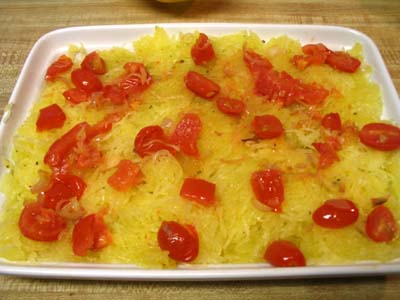 Recipe, words and images reposted with author's permission.
CONTEST! Cooking with quinoa!
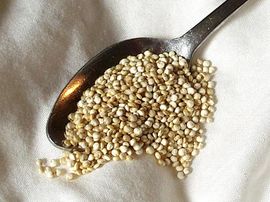 As anticipated a couple of days back, we have got our first vegan cooking contest lined up, on the theme of "Cooking with Quinoa"! We are hoping to present different and creative ways to prepare this highly nutriotious and delicious cereal! So, how it does work? Starting today you can send in by email your recipe, or alternatively you can post a comment to this message with the URL of your blog where the recipe is already published. Ideally, everyone should have on their blog their quinoa recipe, so to allow people to visit your blog and learn more about your page! But you do not need to publish the recipe right away. If you want you can first send it in via email and then publish it later on, when the contest will officially open: all I need to know is that you will have a quinoa recipe on your page during the week of the contest. When we get 7 or more, we will open the contest and let people vote from this page for what they think is the best recipe! If you know you want to submit but you still need some time, leave us a message and we will wait for your recipe to open the contest. Votes will be casted for one week. What is up for grabs? Since we are unable at the moment to offer vegan goodies, we have decided to offer : - an original button of your own site to each contestant, to show with pride on your own blog and to allow others to put on their site
- a blog/site makeover for the winner: if you think your blog could do with a change of look (how dramatic, you decide: we are committing ourselves to go as far as our knowledges can go), or if you are tired with blogger standard templates, all you have to do is to enter the contest with the most amazing quinoa recipe on the planet!
All courtesy of Jo, who kindly did all the design job for this page. There are just a few rules and guidelines you need to follow: - the recipe must be either original (never published previously) or recently published on your blog
- you can use one of your old recipes, but you must change it a bit, so not to post an all time favourite we have all tried in our kitchens before
- it would be best to have a picture of the finished dish as well
- do you need to be part of this club/registered to participate? no: everyone is welcomed, as long as you keep it vegan!
Pretty simple no? If you have any questions, just ask. Beside for the contest, we have other things coming up: today's recipe, submitted by Teddy (we cannot wait to try it!), an article and a recipe submitted by super vegan chef Bryanna and then some vegan history from long time ago. So check back for updates and get to cook with quinoa this week!
Service Note
Ladies and Gents, we are almost ready to share the magic codes to the two blog rolls you see on the left column with you. Once you will be given the magic code, you will be able to magically add the entire list of participants to your blog with one simple, smooth movement. Or not, if you do not want to. Also, if you are coming over here every now and then and would like to be added to the list, leave us a comment! We are definitely still looking for other vegan blogs to add to both rolls! In the meanwhile, we would like to tell you what is coming up: a number of recipes submitted by you, a poll and our first CONTEST! The topic will be "cooking with quinoa" and you are invited to create your own original quinoa dish and submit it for votes on this site! So get yourself sme dry "Inca gold", cook it up deliciusly, take a picture of it and get ready to fight for leadership!!! Unfortunately we cannot yet provide vegan goodies for the winner, but we are working on it! In this first contest, you will be fighting for something more important: glory! Crazy talking aside, please read the following message I received from Kai Vegan and be ready to update your link section: her blog has been hijacked! Hi. I'm on your Vegan Recipe Club as Kaivegan. My blog got hijacked the other day, so you probably want that junk out of your list ASAP. In the meantime, I started a new blog which is housed here:http://kaivegan.com/. From what I know, that could happen to anybody. The blog gets so many hits/visits a day, and the site is vulnerable. The account itself is not what they're up to, but the URL. I still have the archives and was able to transfer them to the new account. I just wish blogger could give me some explanations or help, but I never heard from them.Thanks and apologies for the inconvenience.Kai Vegan was so popular that we are not surprised but we are nevertheless sorry to hear something like that can happen. Make sure to change your link section to the new, correct address: http://kaivegan.com/
Quinoa 'blanc manger' with lytchee and rose jelly.
Blanc-Manger is a typical French sort-of-but-not-quite pudding: you can read some fascinating information about it here. There are a number of traditional and nouvelle cuisine recipes and when travelling throught France, I would definitely suggest you to try at least one!
This is the English translation of Bea's recipe.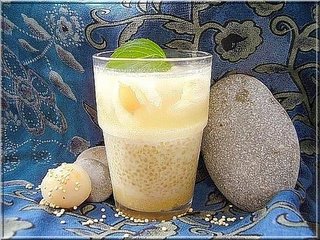 For two glasses, 180 ml in volume each.Blanc-manger : For two glasses, 180 ml in volume each.Blanc-manger :
* 50 gr of quinoa * 2. 5 tablespoons of cane sugar * 100 ml of coconut milk (7 tablespoons) + 60 ml of water (4 tablespoons) * 2 gr of agar-agar for the blanc manger * 40 ml of coconut milk(2.5 tablespoons) ** For the bottom of the glasses :
* 2 tablespoons of coconut jam ( If you do not have coconut jam, prepare in less than two minutes and excellent substitute making boil the same quantity of cane sugar together with water, until the sugar has completely dissolved. At this point add some grated coconut: you should get a thick coconut paste.)** Lytchee and rose jelly :* 8 preserved lytchees * 120 ml of the syrup the lytchees were preserved in (about 1/2 cup) * 2 teaspoons of rose water * 1 gr of agar-agar ** PREPARATION:Rinse the quinoa and eliminate all water. Bring to a boil the cane sugar and the coconut milk+water mix, add the quinoa and let it cook on very low fire until the ring separate from the quinoa and the quinoa grain has absorbed a good portion of the liquid and has become tender. Mix the agar agar powder in the 40 ml of coconut milk and then pour over the quinoa mix and let it boil for 2 or 3 minutes. During this time, put 1 tablespoon of coconut jam at the bottom of each glass, which you will then put into the freezer for 10 minutes. Let the blanc-manger cool 5 minutes and then place it, one spoonful at the time, over the coconut jam. Cool for half an hour in the fridge or freezer. Open a bottle of preserved lytchees. Melt the gram (about 1 teaspoon) of agar agar powder in 120 ml of the lytchee syrup on the stove, together with 2 teaspoons of rose water. Bring to a boil for 2 or 3 minutes. Let cool for 5 minutes. Cut each lytchee in three pieces, and place them on the blanc-manger. Then pour the lythcee syrup and rose jelly. Cool util room temperature before putting in the fridge. Finally, take a little spoon and dive with it in the heart of Paradise, melting jelly, lytchee petals, crunchy quinoa dressed in cocnut pudding, bottom layer of sweet jam.....
A few words with.... Heather Shenkman, the Vegan Doc!
I am not sure about yours, but my general doctor is a lady in her mid fifties, quiet, smily, a bit bored with her patients, with little to no idea of what veganism is all about and not likely to ever find out. Not to talk about my cardiologist, who is a balding, boring man able to look at my heart on the ecography screen with the same passion and enthusiasm you would devote to a brick in a wall.So when I found out there was a young, cool cardiologist, keeping a blog, who is incidentally vegan, I could not refrain from asking her a few questions! And she has been kind enough not only to allow me to add her to The Vegan Club blog roll, but also to answer me: meet Heather Shenkman, the Vegan Doc behind the blog Out Of My Vegan Mind! Heather, when lay people hear I am a vegan, thinking they know more than me and that they are 'doing better', usually they start commenting I may lack calcium, iron, proteins, blah, blah, blah.... But you are a doctor! No arguing who knows most here! What do people untrained in the medical field tell you about your veganism? What is the typical conversation like? Heather, when lay people hear I am a vegan, thinking they know more than me and that they are 'doing better', usually they start commenting I may lack calcium, iron, proteins, blah, blah, blah.... But you are a doctor! No arguing who knows most here! What do people untrained in the medical field tell you about your veganism? What is the typical conversation like?
I hear the same things! But, honestly, it's the standard American diet that is deficient, because it is lacking in fiber and antioxidants that are found in fruits and vegetables and contains way too much fat and cholesterol. With a well balanced vegan diet, it is possible to get all of the nutrients needed in a more healthful manner. What about the doctor community? How do they react to the fact you are vegan? Do they raise objections?
These days, I don't think you'll find a single physician who will tell their patients that they need to include meat in their diet. I think that other physicians respect me for my choice of a vegan lifestyle and realize that it is healthier. So when and why you became vegan? Were you motivated by sheer health reasons or moral motivations were also a push?I went vegetarian at age 16 because I thought it was cruel to eat animals when there were plenty of other options. As I learned more about the horrors of factory farming, and about the health and environmental impact of animal products, I went vegan. I've been vegan now for a year and a half. You are seriously training. Can you share with us some secrets about becoming athletic/staying fit on a vegan diet?The most important part of becoming and staying fit is finding activities that you love, and to change your routine to keep exercise from becoming dull. For example, someone who loves to swim could join a masters swim group, or in the summer swim in the open water instead of in a pool. My diet is full of fruits and vegetables, well more than the five servings a day that are recommended. I also eat whole grains whenever possible instead of white flour. My main sources of protein are soy, beans, seitan, and lentils. And, since I love dessert, I have something "sinful" every day, such as a serving on Soy Dream ice cream or a couple of Fig Newmans. Finally, what do you enjoy most about being a vegan?
I love how great I feel, that at age 30 I am at my peak athletic performance. It's also nice to have a clean conscience, to know that my lifestyle is kinder to the animals and the environment. Thanks a lot and our compliments for your graduation, Heather! Our Vegan Doc graduated from her Cardiology Fellowship on June 4th! Congratulations!!!___________________________________________________Many compliments also to Virgine of Absolute Green, who ended up winning the "Power to the culinary imagination" contest on the topic of cooking with flowers with the recipe re-posted below! Many non veggie people contacted Virginie praising her creativity and ability in creating such a recipe not using any animal product and we thought this to be pretty awesome! Comgratulations!
Recipe: Vegan Cherry Pie
 This is our first "in-house" recipe. We tested it a couple of days back and we hope you will like it! It should be mentioned that we tried to keep low in fat since there are two members of our household who are dieting. However, the recipe is probably best experienced full-fat! For directions on how to obtain better results, read the very bottom. INGREDIENTSPate Brisee Crust:-250 gr regular flour -50 gr non-hydrogenated vegan margarine -a dash of salt -one glass of warm water Filling:-800 grams fresh sweet cherries -250 grams vegan granulated sugar -1 tablespoon cornstarch PREPARATIONStart making the Pate Brisee by putting flour and salt in a bowl. Let the margarine soften at air temperature if needed and cut it into small flakes: add them to the flour. At this point you need to kneed the butter into the flour, so to get some small crumbles of flour and margarine. Make sure not to leave any big pieces of margarine in there: everything hould be pretty small. At this point, when no more flour can be made to stick to the margarine, add the warm water, one tablespoon at the time and just enough to make a non sticky ball out of the flour mix. This ball is supposed to be elastic, resistant and non sticky. Make sure not add too much water or you will have to restart everything over! At this point roll the ball, over it with plastic foil and put in the fridge for at least half an hour. Slowly, boringly and painfully take away all the kernels from the cherries (we promise you it is worth the time and effort!), collecting also all the juice this process may create. Add to the cherries the cornstarch, needed to get the juice out of the cherries and to make a denser syrup, and the sugar. Let sit for at least half an hour. Take the dough out of the fridge and cut it into two parts, one double of the other. Take the bigger portion and roll it thinly with a pinroll over some baking paper to make it big enough to spill out of the edges of your cake baking pan about 1 inch (3 cm). Place it inside the pan and fill with the cherries. Roll out what is left of the ball and place it on top of the cherried. Make sure to glue well together the edges of the two disks, since you do not want syrup to come out from the edges. Cut the excess dough and set aside. Now you have to create a small hole (many holes also works!) in the centre of your cake: this step is needed in order to allow steam to come out. If you force the steam to stay inside, the syrup will be too runny and potentially the pressure will make the syrup come out from the edges anyway. In the hole, place a cone of paper covered with tinfoil or use directly baking paper. With the excess of dough, create some leaves to decorate your pie. They are really easy to make and the result is visually really pleasing! Glue the leaves to the pie with some water. At this point, using your fingers or a cooking paintbrush, brush the entire surface with a thin layer of soymilk. Bake at 180 degrees for 45 minutes.  The cake is best eaten at room temperature or slightly warm. We suggest not to eat it very hot. The slightly saltiness of the crust mixes really well with the sweetness of the filling!Also, in case you do not have cherries, other fruits work as well: strawberries, blueberries, blueberries and pears, prunes. These fruits instead leave a bitter taste behind, so avoid: kiwis, oranges. We think fruit melanges do not work all that well, but should you find a good combination of fruits, please let us know! If you want a richer dough, use 100 grams of margarine instead than 50 and less water: the dough will seem dried when handled, but once cooked it will be a lot softer and more deliciously fat in your mouth! The cake is best eaten at room temperature or slightly warm. We suggest not to eat it very hot. The slightly saltiness of the crust mixes really well with the sweetness of the filling!Also, in case you do not have cherries, other fruits work as well: strawberries, blueberries, blueberries and pears, prunes. These fruits instead leave a bitter taste behind, so avoid: kiwis, oranges. We think fruit melanges do not work all that well, but should you find a good combination of fruits, please let us know! If you want a richer dough, use 100 grams of margarine instead than 50 and less water: the dough will seem dried when handled, but once cooked it will be a lot softer and more deliciously fat in your mouth!
|
|
29
|
| |

|
|
| Until one has loved an animal, a part of one's soul remains unawakened. Anatole France
|
|
|
 PREPARATION
PREPARATION











 What's your favourite out of the above? We like a lot the SuperVeganMan! Got any more to share?
What's your favourite out of the above? We like a lot the SuperVeganMan! Got any more to share?

 DELIGHTFUL MILLET
DELIGHTFUL MILLET



 4- Erin at
4- Erin at  5- Melody at
5- Melody at  6- Primary Consumer at
6- Primary Consumer at  7- Virginie at
7- Virginie at  8-Teddy at
8-Teddy at 




















